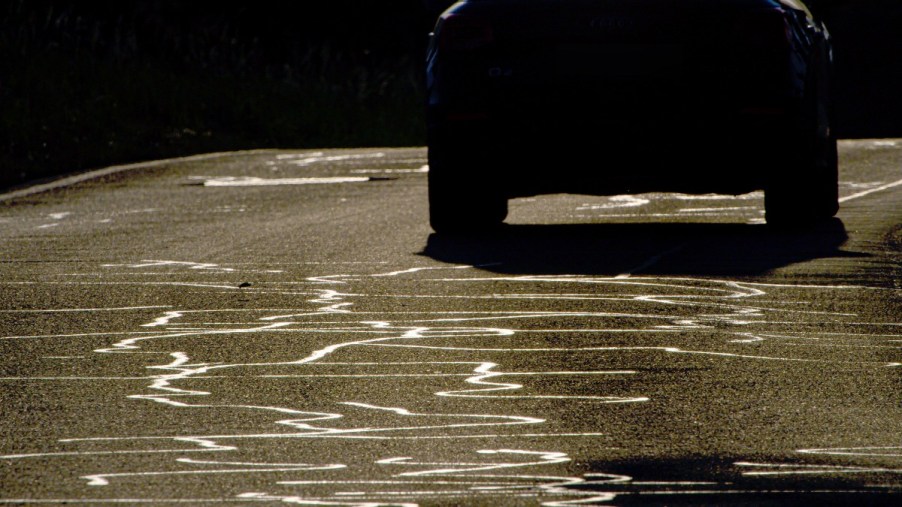
What Are the Weird Snake-Like Black Tar Lines on Roads?
At some point, you likely drove your car on a road with weird, squiggly, snake-like black tar lines. The black tar lines are especially common on rural roads. These lines often appear to meander across the asphalt haphazardly, with no rhyme or reason to where they go. It might seem like these black tar lines are a result of sloppy road construction work. However, they serve an important purpose for road maintenance.
Why do road construction crews put black tar lines on roads?

The purpose of the black tar lines is to seal cracks in the road. The black tar lines are a relatively quick and inexpensive way to repair damaged road surfaces, compared to tearing up and repaving the entire road.
As detailed by How Stuff Works, while the lines in the road look like tar, they usually are a “high-performance polymer-asphalt mix, designed to form a bond that’s flexible enough to keep the road from cracking even more.” Road construction crews “apply it to the fissures with a device that looks vaguely like a vacuum sweeper hose.”
What causes cracks to form on roads?

Cracks on roads form when “stress builds up in the surface layer that exceeds the tensile strength of the asphalt.” The road stress is the result of the pounding of traffic over time. Also, cracks form when the road expands and contracts during seasonal changes in temperature. This is why you’ll often see cracks, as well as potholes, form in the road in the spring, as temperatures rise following a cold winter.
Another cause of road cracks is design and construction flaws. Examples include a weak base underneath the road and not enough drainage for rainfall.
What are cracks in the road called?
There are many different types of road cracks — and they have many different names. One type is fatigue cracking, which looks like an alligator’s hide. This usually requires extensive repairs. Another road crack is called edge cracking, which is rows of wavy cracks that are parallel to the road shoulder.
A third type is reflection cracking, which “results from movement between the road’s asphalt and concrete layers, and looks more like a jagged gash.” Additional road crack types include block cracking, longitudinal cracking, transverse cracking, slippage cracks, and joint reflection cracks.
Cost of black tar to repair road cracks vs. resurfacing an entire road
As noted earlier, one of the benefits of using black tar to repair road cracks is that it is considerably more inexpensive than tearing up and resurfacing an entire road. In 2008, the Texas Engineering Extension Service at Texas A&M University did a study on the cost of road repair. It estimated that crack sealing “costs about $2,500 per mile of road, compared to $60,000 for putting down an overlay surface.”
Also, “in 2016, the City of Littleton, Colorado, estimated that crack sealing cost about $5,500 per lane mile, while overlaying cost approximately $320,000 per lane mile.”
Motorcyclists call the black lines on the road tar snakes
The black tar lines help maintain the quality of roads and prevent them from deteriorating further. However, some motorcyclists call the lines tar snakes and express concerns that they damage bikes and cause accidents. The Bikebandit humorously states, “The tar snake is a nasty species found across the country that has an appetite for motorcyclists. Find out what these are, and what to do when you encounter them, so you don’t end up a victim when they bite!”
This article was updated on 7/20/2022.


